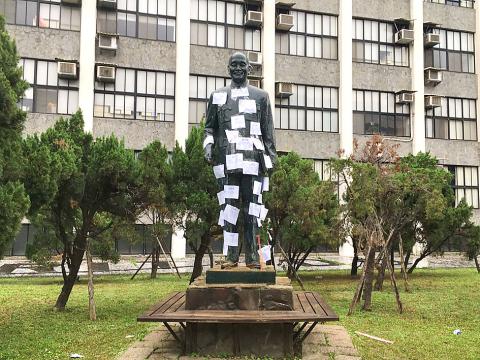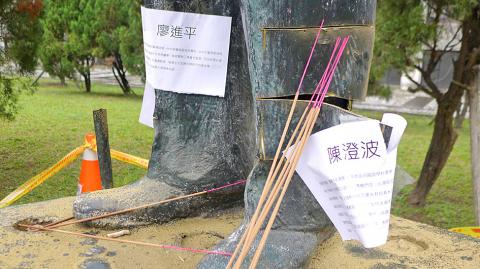Three students and a fourth person were arrested at New Taipei City’s Fu Jen Catholic University at 1am yesterday after allegedly attempting to topple a bronze statue of Chiang Kai-shek (蔣介石) and obstructing police officers.
Equipped with an angle grinder, a generator and a rope, student Lo Yi (羅宜) allegedly began cutting the statue at 12:30am, which drew the attention of university guards.
Officers from the Sinjhuang Precinct’s Fuying Police Station arrived minutes later.

Photo: CNA
Precinct investigation brigade head Chang Chun-ming (張俊明) told the students that their actions were in breach of the Social Order Maintenance Act (社會秩序維護法) and constituted vandalism, adding that they would be arrested if they did not stop.
A crowd near the statue told officers that they had no right to arrest students on campus unless the university gave them permission.
Chang said that the officers were acting on a request by the university.

Photo: Lee Ya-wen, Taipei Times
Chang and several colleagues engaged in a loud exchange with Lo and others. They pulled Lo away from the statue, prompting scuffles.
Lo and another student, surnamed Chen (陳), were subdued by several officers and handcuffed.
A woman, surnamed Chen (陳), who the police said was “making irrational remarks,” was also handcuffed.
Another student, surnamed Lin (林), who was taking photographs at the scene, was also detained.
Lo was detained for breaches of the act, while the others were obstructing police officers in the course of their duties, Chang said.
They were taken to the precinct for questioning and at 8am were sent to the New Taipei City District Prosecutors’ Office.
They were later released after the university said it would not file charges.
Lo made a hole near a foot of the statue and broke a cane Chiang holds, the university said, adding that repairs would cost about NT$5,000.
Lo said that statues of Chiang on campuses nationwide are defaced or tampered with by students ahead of Feb. 28 every year and are restored.
However, it is time they are toppled “once and for all,” he said.

Trips for more than 100,000 international and domestic air travelers could be disrupted as China launches a military exercise around Taiwan today, Taiwan’s Civil Aviation Administration (CAA) said yesterday. The exercise could affect nearly 900 flights scheduled to enter the Taipei Flight Information Region (FIR) during the exercise window, it added. A notice issued by the Chinese Civil Aviation Administration showed there would be seven temporary zones around the Taiwan Strait which would be used for live-fire exercises, lasting from 8am to 6pm today. All aircraft are prohibited from entering during exercise, it says. Taipei FIR has 14 international air routes and

Taiwan lacks effective and cost-efficient armaments to intercept rockets, making the planned “T-Dome” interception system necessary, two experts said on Tuesday. The concerns were raised after China’s military fired two waves of rockets during live-fire drills around Taiwan on Tuesday, part of two-day exercises code-named “Justice Mission 2025.” The first wave involved 17 rockets launched at 9am from Pingtan in China’s Fujian Province, according to Lieutenant General Hsieh Jih-sheng (謝日升) of the Office of the Deputy Chief of the General Staff for Intelligence at the Ministry of National Defense. Those rockets landed 70 nautical miles (129.6km) northeast of Keelung without flying over Taiwan,

City buses in Taipei and New Taipei City, as well as the Taipei MRT, would on Saturday begin accepting QR code payments from five electronic payment providers, the Taipei Department of Transportation said yesterday. The new option would allow passengers to use the “transportation QR code” feature from EasyWallet, iPass Money, iCash Pay, Jkopay or PXPay Plus. Passengers should open their preferred electronic payment app, select the “transportation code” — not the regular payment code — unlock it, and scan the code at ticket readers or gates, General Planning Division Director-General Liu Kuo-chu (劉國著) said. People should move through the

The Ministry of National Defense (MND) today released images of the military tracking China’s People's Liberation Army (PLA) movements during the latest round of Chinese drills around Taiwan. The PLA began "Justice Mission 2025" drills today, carrying out live-fire drills, simulated strikes on land and maritime targets, and exercises to blockade the nation's main ports. The exercises are to continue tomorrow, with the PLA announcing sea and air space restrictions for five zones around Taiwan for 10 hours starting from 8:30am. The ministry today released images showing a Chinese J-16 fighter jet tracked by a F-16V Block 20 jet and the